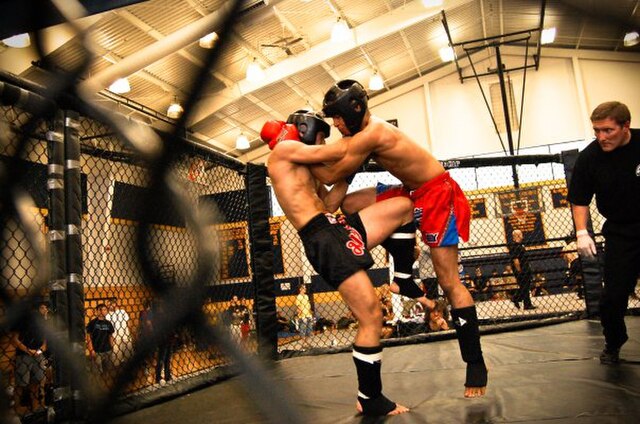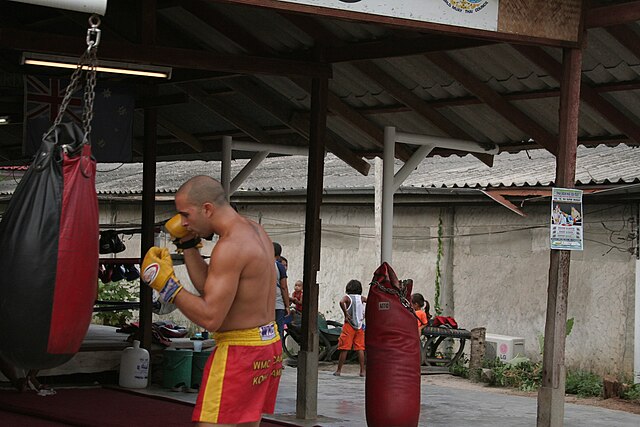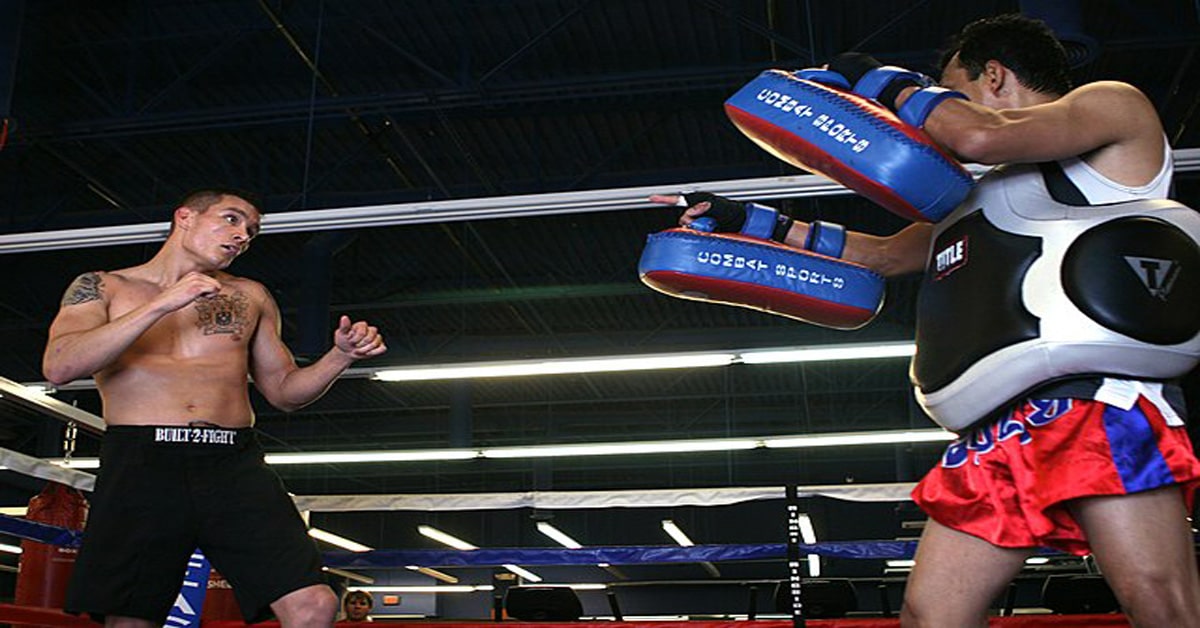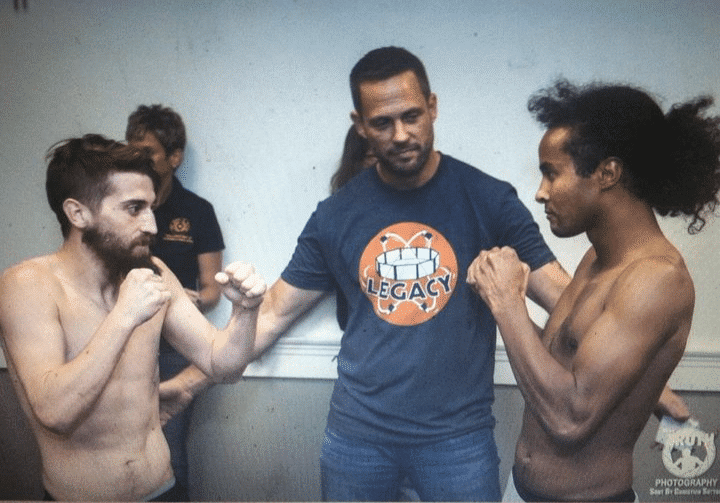Muay Thai Workout Routine
A traditional Muay Thai workout routine is one of the most effective forms of fight training. They’re made up of different elements which improve skill while also improving conditioning.
Here is a basic layout of a traditional Muay Thai workout routine. Going over everything that makes up a Muay Thai training session.
What Does a Traditional Muay Thai Workout Consist of?
A traditional Muay Thai workout routine consists of a mixture or all of these types of training.
- Running
- Skipping Rope
- Shadow Boxing
- Bag Work
- Pad Work
- Sparring
- Technical Sparring
- Clinching
- Abs
- Stretching
- Weight Lifting(Optional)
Running/Skipping Rope
Every traditional Muay Thai workout routine begins with running. Thai boxers get up at five A.M. every day to get in their morning run. Going between 3-5 miles(5-10 km).
After they return to the gym from their run, they will get some water and continue their warm-up before fight training. They will do a few rounds of jump rope and shadowboxing before wrapping their hands for striking.
Bag Work/ Pad

For the next phase of a traditional Muay Thai workout routine. a fighter then moves on to rounds of bag and pad work. In a Muay Thai gym, there are usually more students/fighters than instructors.
That means the people training will rotate from bags to the trainers with pads. They will complete between 3-5 rounds or more of both types of training in this training segment.
Sparring/Technical Sparring
Muay Thai sparring is a big part of a traditional Muay Thai workout routine. Unlike Western boxing, Thai boxers tend to spar more technically than going all out.
Thai boxers fight every few weeks and can’t be hurt in training. This is why they do more technical sparring to avoid getting damaged before a fight.
Fighters will do at least five rounds of sparring to match the number of rounds in an actual fight.
Clinching

A traditional Muay Thai workout routine doesn’t just consist of striking. Clinch fighting is an important part of Thai boxing, so fighters dedicate training sessions to wrestling. Thai boxers will do a mixture of drilling and live clinching rounds without strikes.
Strength, Conditioning, & Stretching
Along with their running and rounds, Thai boxers also combine strength, conditioning, and stretching into their Muay Thai workout routine. Fighters will either mix these into their training sessions or do them in a separate training session.
Thai boxers don’t all do the same strength conditioning and stretching routines but do many of the same movements.
This part of a traditional Muay Thai workout routine may include:
- Push-Ups
- Weight Training
- Ab Exercises
- Stretching
- Yoga Movements
What is the Traditional Time of Rounds in Traditional Muay Thai Workout?
The rounds in a traditional Muay Thai workout routine generally 3 minutes each, just like the pros fight in. Amateurs may do 2-minute rounds, but almost all Muay Thai gyms in Thailand do 3-minute rounds.
A Traditional Muay Thai Workout Routine of a Thai Boxer
A traditional Muay Thai workout routine is systematically structured to push a fighter to their limits while improving their abilities. Here is a breakdown of the average conventional Muay Thai workout routine of a Thai boxer.
Morning Training Session
- Morning Run
- 3-5 Rounds of Shadowboxing & Skipping Rope
- 3-5 Rounds of Bag Work
- 3-5 Rounds of Pad Work
- Cool Down/Stretching
Every Thai boxer trains all day and all night. Their days start with an early morning run. Distances may vary by gym and how many miles a trainer makes their fighters run each day.
Once the fighters return to the gym, they will get some water and catch their breath for Muay Thai training. Some gyms might make their fighters go through warm-up rounds of shadow boxing or jumping rope before their training rounds.
For the rest of the morning, Thai boxers will do various rounds of bad work and pad work.
Rest Period
After completing the first traditional Muay Thai workout of the day, fighters will have a rest period. During midday, the fighters will have their lunch and rest up before their afternoon training session.
A normal rest period between sessions is around 2-4 hours for the fighters to recover their energy.
Afternoon Training Session
- 3-5 Warm Up Rounds
- 3-5 Sparring Rounds
- 3-5 Clinch Wrestling Rounds
Once rested up, Thai boxers will then get ready for their second training session of the day. They usually only run in the mornings, so in the afternoons, they warm up with jump rope and shadow boxing.
After the fighters get warmed up, they’ll gear up and begin their second training sessions. Some Thai boxing gyms do rounds of sparring and clinching.
Fighters will mimic the tempo of a fight without putting 100% into their strikes and usually holding back so as not to hurt a training partner and cost them money.
In fight camps, this session usually lasts between 1-2 hours or more. Trainers will push their fighters physically while also preparing them mentally by going over their game plans.
Strength & Conditioning Session
- Push-Ups
- Ab Exercises
- Weightlifting Sets
- Sprints
- Box Jumps
- Body Conditioning
Strength and conditioning are becoming more important in Muay Thai as sports science improves. Some fighters may mix it into their training sessions or have a separate strength and conditioning session.
They’ll use different movements to build, condition, and stretch their muscles to get into fight shape.
Do All Thai Boxers Use The Same Muay Thai Workouts?

There isn’t just one particular Muay Thai workout that all fighters use. The workouts in Muay Thai vary from gym to gym and fighter to fighter, and whichever opponent they will be facing.
Remember that not all Muay Thai gyms use the examples of training sessions listed below. Some gyms might spar in the morning and do pad work in the afternoons.
Many Muay Thai gyms will even switch their sparring and bag work sessions day-to-day to change things up.
How to Create a Muay Thai Workout?
How Often Will Fighter Do Muay Thai Workouts?
Thai boxers generally train 5-6 days a week, with multiple Muay Thai workouts performed daily. These grueling training sessions are the keys for fighters to improve their skills and conditioning to become the best athletes possible.


